One of the best parts of Dungeons & Dragons is identifying and divvying up loot. Whether your DM is sneaking in some homebrew items or you’re just getting cool swag from the Dungeon Master’s Guide, equipping your character with new gear always feels good.
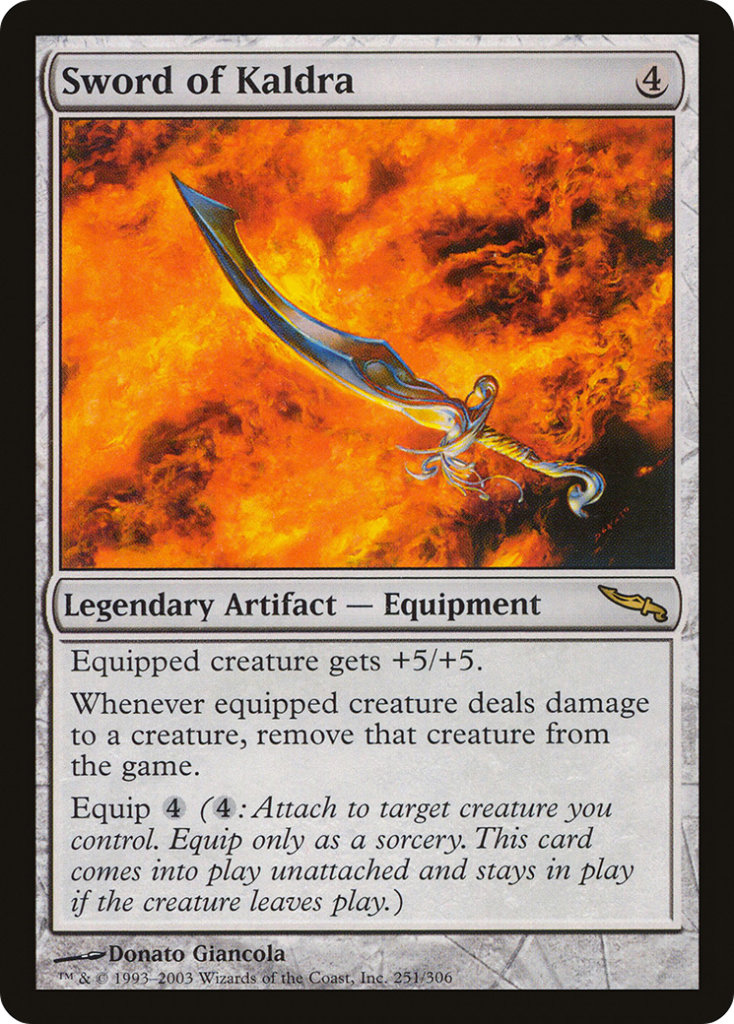
That’s why it constantly surprises me that it took Wizards of the Coast (WotC) over 6 years to introduce this concept to Magic: the Gathering after their acquisition of D&D in 1997 – especially when you consider they had been using Auras through enchantments since Alpha!
Being introduced in Mirrodin, the first of 3 sets in a block revolving around artifacts and whose mechanics were integral in teaching me how to play, Equipment hold a special place in my heart. I even have a Sram, Senior Edificer Commander deck revolving around them that I’ve enjoyed playing for years.
Some Equipment are so good, however, that they also fit in a wide variety of other Commander strategies. In order to see what sets the cream of the crop apart from the chaff, let’s take a quick moment to see how they work.
How Does Equipment Work in MTG?
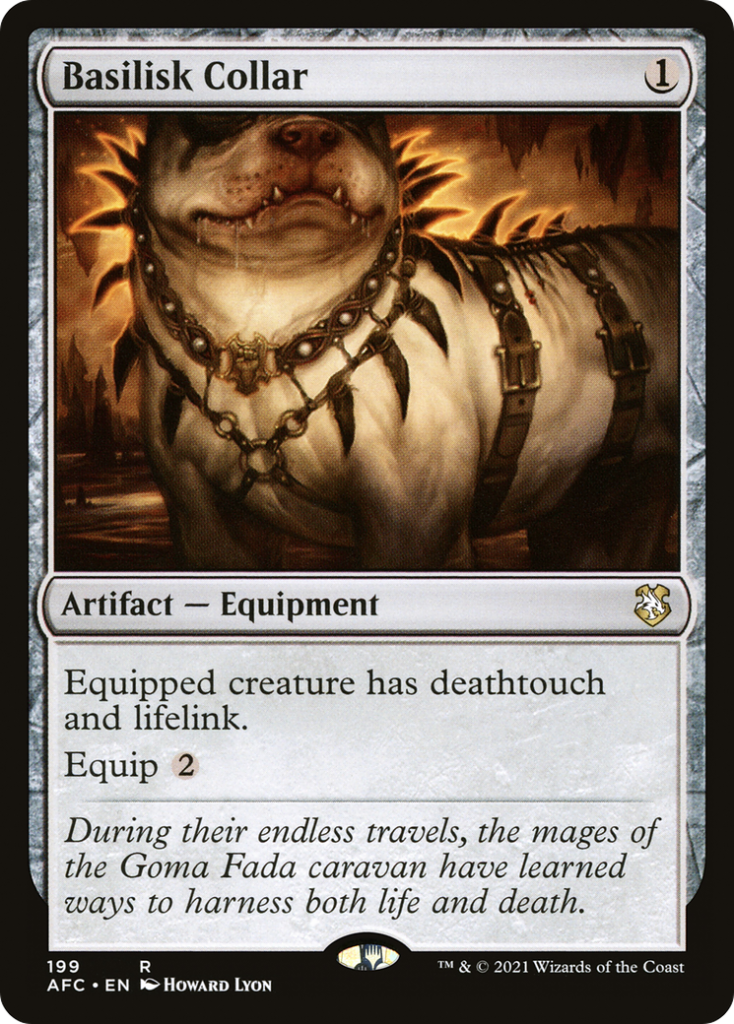
Equipment are a subtype of Artifacts, and have the ability “Equip”, which can be used at sorcery speed. To Equip one of your creatures, you pay the Equip cost, then it becomes equipped to the targeted creature. You may also move this Equipment to another one of your creatures by paying the cost again at sorcery speed.
Unless a card specifically states otherwise, you may only ever Equip your own creatures. If you lose control of an equipped creature, the Equipment stays attached to them, but you may still move it to one of the other creatures under your control at sorcery speed.
Finally, if an equipped creature dies or is removed from the battlefield, the Equipment that was attached to it remains on the battlefield – a nice upside when compared to Auras, which go to the graveyard!
For other specifics pertaining to how Equipment work, you should refer to the Comprehensive Rules, starting at section 301.5.
Traits of Good Equipment Cards in MTG
- Low mana value: Equipment typically don’t do anything when they enter the battlefield, so you generally don’t want to invest more than 3 mana to cast one unless the payoff is phenomenal.
- Low Equip cost: The lower your Equip cost, the easier it is to arm a creature and/or move your equipment to other creatures, perhaps even after combat.
- Impactful ability or abilities: Simply boosting power and toughness is almost never enough to make an equipment playable outside of certain Voltron builds (strategies that load up one creature, often a commander, to be as big as possible through multiple sources). A good Equipment card needs to be generating some form of lasting value or additional benefit beyond this.
Since the abilities of Equipment can vary so dramatically, this will not be a list attempting to even loosely arrange the best ones by power level. Granted, the majority of Equipment cards are geared toward attacking with at least 1 creature on a regular basis, but many among the best simply fall outside that mold.
Naturally, this also means that a card’s exclusion from this list should not automatically exclude it from consideration for your Commander deck if it fits the needs of your strategy. WotC has experimented within this design space a lot over the last 20 years, so there are dozens of Equipment cards to choose from, and more being released all the time.
Darksteel Plate

Darksteel Plate is probably my favorite piece of Equipment ever printed. With the abundance of targeted and global removal for creatures in Commander, an Equipment card that stops most of them in their tracks is nothing short of perfect for strategies that revolve around your commander or are bolstered by keeping a specific creature alive.
Better still, Darksteel Plate, like most cards with Darksteel in their name, is itself Indestructible, shrugging off most of the plentiful artifact removal that roams the table, unlike Hammer of Nazahn. It’s also far easier to cast and equip than Shield of Kaldra, making it one of the most efficient protective Equipment you can run.
And since it’s colorless, it can be a boon for any Commander deck. As long as you avoid errant counterspells, of course.
Lightning Greaves & Swiftfoot Boots
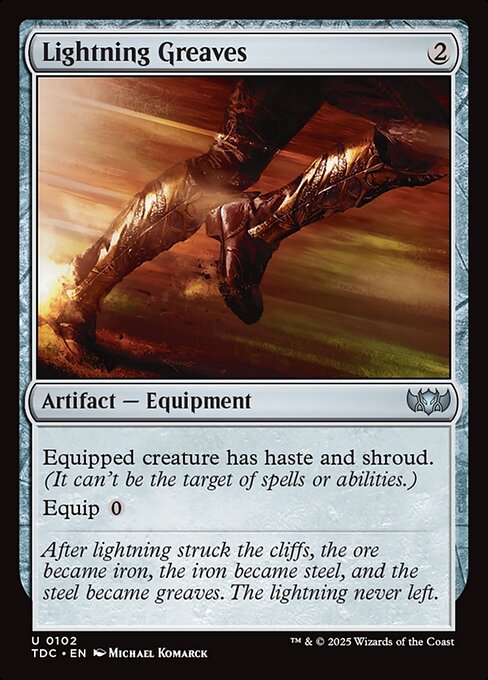

Lightning Greaves and Swiftfoot Boots were cut from the same cloth, and have seen extensive play in the Commander format for over a decade. 2 mana for an Equipment card that provides haste plus protection from targeted effects is already good, and the incredibly low Equip cost make both cards ideal for fast attacks that are difficult to answer.
Naturally, this means decks that want these Equipment will either be running big creatures that want to swing at opponents as soon as possible or strong effects that result from tap abilities, tapping creatures through combat, or combat triggers.
Of the pair, Lightning Greaves is usually the better card. A free Equip cost makes it easy to move this card where it is needed both before and after combat, and in combination with Leonin Shikari, effectively gives all your creatures Shroud.
Shroud’s protection can backfire if you only have 1 creature in play though, so make you load up any other targeted effects onto your creature before attaching this fancy footwear.
Swiftfoot Boots came around after Wizards had begun distancing themselves from the Shroud keyword, electing for a replacement that is more one-sided in its protection through Hexproof. While many consider this card the “fixed” version of Lightning Greaves, an Equip cost of 1 is hardly an impediment, meaning many decks simply play both cards.
Skullclamp

Skullclamp is in my top 2 for the most broken Equipment ever printed, and it came about through a last-minute change toward the end of Darksteel‘s development. A draw engine that can go in every deck is already dangerous, the fact that it’s one of the most efficient draw engines ever printed exponentially compounds the possibilities for it to snowball.
At its fairest, you staple Skullclamp to a threat, menace your opponent with it until they have to kill it, then draw 2 cards when they do. At a mere 1 mana to cast AND Equip, you can do this pretty much from the start of the game and net consistent value until you eventually get hit by an artifact removal spell.
If your deck plays a lot of creatures or creature tokens with 1 toughness, however, this card effectively reads: Pay 1 mana: Sacrifice a creature, then draw 2 cards. Unless you have access to cards like Necropotence, you simply won’t get a better rate than that in most decks, making it very easy to run away with games through raw card advantage.
Shadowspear
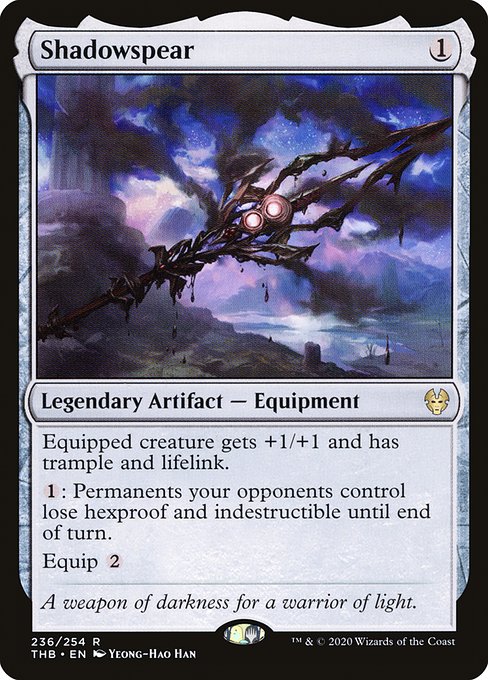
Shadowspear‘s low casting cost, reasonable equip cost, and the plethora of boons it offers an equipped creature hearkens back to Basilisk Collar, a card that saw years of tournament and Commander play after its release in Worldwake.
While its Legendary status means you can’t copy it with cards like Masterwork of Ingenuity, Shadowspear does something almost no other equipment card does – it gives you an activated ability you can use while it isn’t equipped.
And it’s a doozy.
Stripping away Hexproof and Indestructible not just from opposing creatures, but all opposing permanents allows you to circumvent many difficult to answer pemanents, including Theros gods like Xengaos, God of Revels, pesky protection cards like like Darksteel Plate, and shielded lands like Lotus Vale.
This makes Shadowspear a great tool to slot into equipment packages, Trinket Mage‘s bag of tricks, or simply as a silver bullet to deal with specific metagames. And if you get to take advantage of the +1/+1, Trample, and Lifelink, that’s a nice bonus.
Conqueror’s Flail

Conqueror’s Flail is more of a cEDH darling, but its applications are relevant at all levels of Commander play. Like Shadowspear, the power boost from equipping it is nice, but the second ability is why it is such a sought after card.
As long as Conqueror’s Flail is attached to a creature, your opponents can’t cast spells during your turn.
If you’re wondering whether you read that ability correctly, you probably are. Shutting off almost every means of interaction from your opponents is a combo player’s dream, ensuring they can casually assemble the cogs of their machine without fear of reprisal in game (It won’t save you from the out of game ones though – hopefully your playgroup contains good sports).
Not having to worry about interactions in fair game states is incredibly useful too. Blowouts from Settle the Wreckage, Cyclonic Rift, or Counterspell will become issues of the past as you cast big spells, attack with your creatures, or simply lay critical groundwork for future turns.
Swords of X and Y (Sword of Feast and Famine, Sword of Fire and Ice, Sword of Hearth and Home, Sword of Sinew and Steel, etc.)

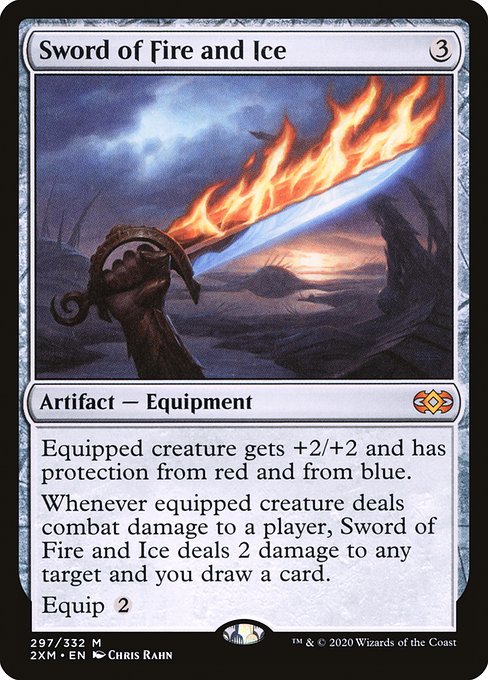
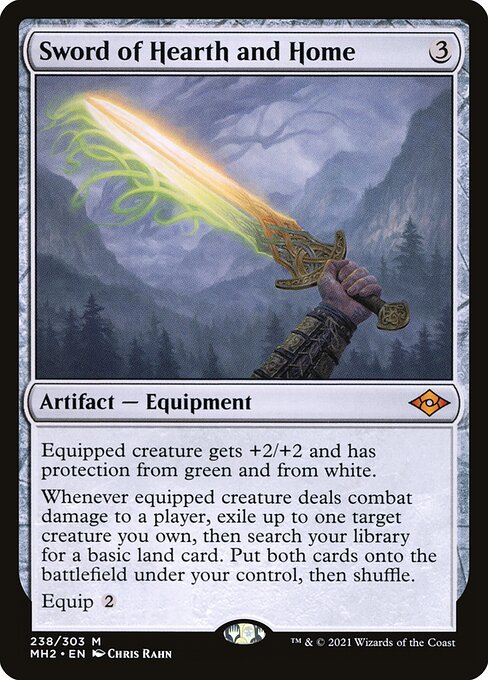

An incredibly powerful series of Equipment that were introduced in Darksteel, the swords of X and Y have been casual favorites for years and years.
These are characterized by costing 3 mana, Equipping for 2, providing an equipped creature +2/+2 and protection from 2 colors, and granting 2 effects when the equipped creature deals combat damage to a player. Even the weakest of these, Sword of Body and Mind, delivers incredible value far in excess of these costs, making the swords highly sought after for a wide variety of decks.
Sword of Feast and Famine is widely considered the best sword of the batch, but Sword of Fire and Ice and Sword of Hearth and Home aren’t too far behind it in terms of sheer value, and all of them see extensive play across the Commander format.
This high amount of play doesn’t strictly stem from their powerful triggered effects, however. Providing protection from two colors often renders the equipped creature unblockable, untargetable, and undamageable by at least one person at the table, which dramatically raises your odds of getting to repeatedly use your swords’ effects.
Talk about synergy. If you see one of these come up across the table, finding a way to destroy it is almost always a valid play, as these will run away with games very quickly.
Sunforger
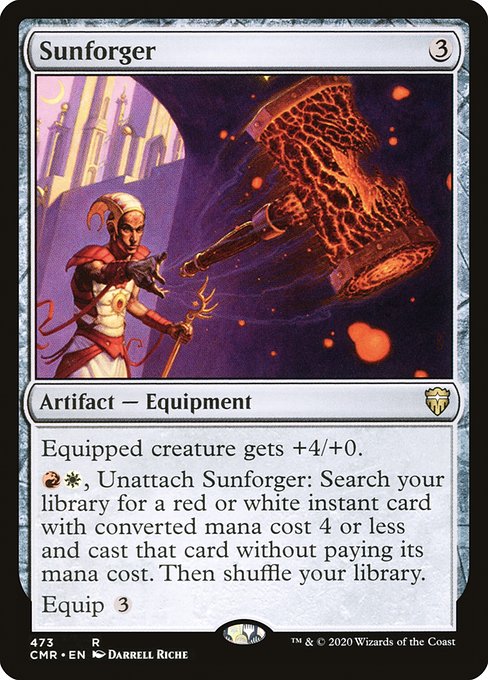
Speaking of problematic Equipment that should be destroyed on sight, let’s talk about Sunforger. Restricted to use within decks that contain both red and white, this card can easily transform your deck into a convenient toolbox for counterspells, protection effects, card draw, spot removal, and more.
The primary drawback of Sunforger is that it is mana intensive, as playing it, equipping it, and using its effect will cost a whopping 8 mana total. That said, even if you don’t use it to tutor, +4/+0 will turn most creatures into instant threats, allowing you to aggressively attack or keep a deadly blocker up.
All while biding your time and waiting for the most disruptive moment to detach Sunforger and ruin someone’s otherwise well laid plans.
Umezawa’s Jitte

Umezawa’s Jitte is the 2nd of what I consider the 2 most broken Equipment cards in the game, and it’s impossible for me to say which is more dangerous. 2 mana to cast and equip this Legendary card is already a good rate, and the fact that it generates 2 counters, which you can use even while it is unattached, anytime its equipped creature deals combat damage (that’s attacking OR blocking) is insane.
What does removing these counters do, you ask? The short answer is win you games you had no business turning around, let alone winning. The longer answer involves explaining what a removed counter can do:
- Give the equipped creature +2/+2 until end of turn
- Give target creature -1/-1 until end of turn
- Gain you 2 life.
Since you’ll be giving the death fork counters while attacking and blocking, it becomes laughably easy to get enough counters to stabilize your life total, remove opposing chump blockers, and create a must-answer attacking threat that will either kill whatever is thrown in front of it (then gain more counters), or gain a potentially lethal boost in power with existing counters if left unblocked.
Bonus points if you staple this to a creature with Double Strike, as the counters get added with each instance of combat damage, but Umezawa’s Jitte is plenty good on any creature that can hold it.
Common MTG Equipment Questions
How Many Equipment Can One Creature Have?
There is no limit to how much equipment you can attach to a creature. Abilities like Shroud and Protection from Artifacts will prevent you from equipping a creature, however.
Can an Equipment be a Creature?
Some Equipment, like Haunted Plate Mail, can turn itself into a creature. Equipment can also become creatures through the use of cards like Karn’s Touch. Equipment cannot be equipped while it is a creature, unless it has the Reconfigure ability, introduced in Kamigawa: Neon Dynasty.
Can an Equipment Equip Itself?
No. Equipment also cannot equip anything while it is a creature unless it has the Reconfigure ability, introduced in Kamigawa: Neon Dynasty.
Can You Unequip Equipment?
No. Once an Equipment is equipped, there are only 3 ways to remove it from a creature outside of a card effect:
- Equip the Equipment to a different creature you control
- Remove the Equipment from the battlefield
- Remove the equipped creature from the battlefield
What Happens to Equipment When a Creature Dies?
Unlike Auras, Equipment remain on the battlefield after a creature they are equipped to dies.
Is Equipping Instant Speed?
No, equipping is done at sorcery speed. A card like Leonin Shikari is needed to Equip at instant speed.
Can You Put Equipment on a Planeswalker?
No, Equipment may only be equipped to creatures. If a planeswalker becomes a creature, like Gideon Blackblade, you may Equip them then, but the Equipment will unattach when the planeswalker stops being a creature.
Can Equipment Be Tapped?
Yes, though you’ll usually need to use the ability of a card like Clock of Omens or Inspiring Statuary to do so. Tapped equipment still function as normal, so you may still use their effects or Equip them.
Does Equipment Have Summoning Sickness?
If it is a creature, it will be affected by summoning sickness if it was not under your control since the beginning of your turn. If it is not a creature or has the Reconfigure ability, you may Equip it immediately after you play it.
Other MTG Articles You Might Enjoy
Braden is a founder of Assorted Meeples and has been a gamer & writer with a vivid imagination all his life. Don’t believe us? Check out his excitement when meeting Goosebumps author R.L. Stine as a kid! An avid Magic: The Gathering spellslinger for over 15 years, you can always convince him to shuffle up for a game (or three!) of Commander.
